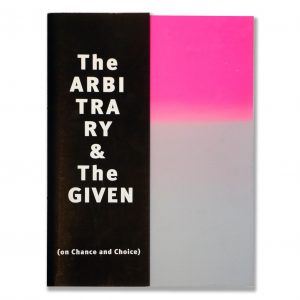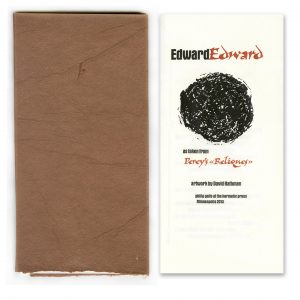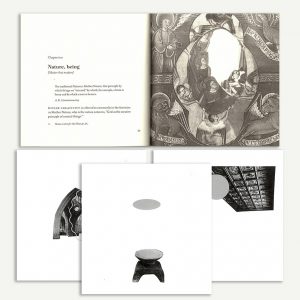- You cannot add "Masterless Universe" to the cart because the product is out of stock.
Sichere Anleitung zum Bestehen jeder Universitätsaufnahmeprüfung im Fach Japanisch (A Safe Method to Pass University Entrance Exams)
Sichere Anleitung zum Bestehen jeder Universitätsaufnahmeprüfung im Fach Japanisch (A Safe Method to Pass University Entrance Exams)
Date
2003
Edition Size
40
Media
Ink, Letterpress
Binding
Hand-sewn
Format
Artist Book
Dimensions
19.3 × 13.4 in
Collection
Limited Edition Artists Books$ 3,900.00
Unavailable
View Collectors
Bayerische Staatsbibliothek
Bowdoin College
Cornell University
Deutsche Nationalbibliothek
Florida Atlantic University (FAU), The Jaffe Book Arts Collection
Herzog August Bibiothek
Lafayette College
Nanyang Technological University
National Diet Library, Japan
Princeton University
Reed College
Rochester Institute of Technology, The Wallace Center, Melbert B. Cary, Jr. Graphic Arts Collection
Stanford University
State University of New York (SUNY), University at Buffalo
Swarthmore College
The New York Public Library (NYPL)
The Ohio State University (OSU)
The University of Chicago Library
The University of the Witwatersrand, Wits Art Museum (WAM), Jack Ginsberg Centre for Book Arts
University of California, Irvine (UCI)
University of California, Los Angeles (UCLA), William Andrews Clark Library
University of California, San Diego (UCSD)
University of Kansas, Spencer Museum of Art
University of Southern California (USC)
Washington University in St. Louis
Western Michigan State University
Yale University, Robert B. Haas Family Arts Library
In A Safe Method to Pass University Entrance Exams, Veronika Schapers puts two versions of a single story – the original Japanese and a German translation – together in a mirrored format. The story, by Shimizu Yoshinori (born 1947), describes the Japanese system of entrance examinations in a humorous yet socio-critical way. This procedure, which is also known as the “examination hell” is not only applied to universities, but depending on the status and type of school, also to high schools, elementary schools, and even Kindergartens. In general, it is much more difficult to pass the entrance exam than to graduate from a university. These examinations do not share any particular format, every university has its own scheme. To prepare for this, there are lots of cram schools in Japan, each specializing in a certain university’s entrance exam. As a result, some students start to prepare years in advance, even before finishing high school.
“I read Shimizu Yoshinori’s text for the first time when I was preparing for a Japanese proficiency test for foreigners which is held once a year by the Japanese Ministry of Education. Talking about this to Japanese friends, I recognized that almost everyone had experienced the ‘examination hell’ and understands the situation of the protagonist Asaka Ichiro very well. In the book I printed the Japanese original as well as the translation into German by Katja Cassing. As the German and Japanese way of reading differ (German: left – right, Japanese: right – left) the book has two beginnings: the German text starts in “front”, the Japanese in the “back”. Both of them meet in the middle with the imprint. In addition to this each page of the German translation refers in color and content to its Japanese counterpart.
The fonts I’ve used are Transit and Kozuka Gothic, both sans-serif fonts that are plain but not stiff. The continuous text is interrupted by examples of examination questions in a bold font. The text was printed by zinc-clichés in letterpress printing. Each double-spread page is underlaid with a pattern of stamps that in Japan are usually used to mark student homework. These marks range from ‘Done very well’ to ‘Normal’ up to ‘Try harder.’ I’ve reduced the original stamps so much that on the very first glimpse they give the impression of a wallpaper-like pattern and even the Japanese reader has to watch carefully to recognize the well-known stamps. Because of the thin Mitsumata paper the marks shine through the pages. Every single page is stamped by hand. To get the colors I had in mind, I mixed them from lithograph printing ink. The book is stitched with a Japanese binding and as a cord I used a twisted paper strip. The cover consists of Kozo cardboard with a thin layer of Ganpi paper giving a fine shine. I printed a pattern of one single stamp in the original size on it saying: ‘You have to try harder.’ This stamp is the worst mark you can get in Japan and stands in contrast to the one I’ve used at the end of the text for the imprint (‘good’). The book is kept in a case in the shape of an Omamori, charms that are sold at Shinto shrines. As a model I’ve used an Omamori from the Yushima Jinja shrine in Tokyo, a shrine which belongs to the Tenmangu sect, founded after the death of the scholar Sugawara Michizane (845-903). He is known as the saint of learning (Tenman Daijizai Tenjin order of: Tenjin-sama) and there are around 12000 shrines of the Tenmangu-sect in Japan, visited by countless students every year (Kangmin Zeng, Dragon Gate, London 1999, pg. 205-218). Instead of the normal charm for successful studying, I embroidered the title of the story on the case, thus going one step further than the normal charms by promising to supply a method of how to guarantee passing the examination.”
– Veronika Schapers
Black letterpress print of the text by zinc-clichees in German and Japanese. Japanese rubber stamps for school marks are printed by hand with printing ink in various colors on Mitsumata paper. Japanese binding with twisted paper cord. Cover made of Kozo Ganpi cardboard printed with rubber stamps in light pink. Padded case made of cotton fabrics in the shape of a Japanese Omamori-charm, with the Japanese title embroidered in ivory.
Original Japanese text by Shimizu Yoshinori. German translation by Katja Cassing.
Edition of 40, copies numbered. 34x49cm. 2003.






